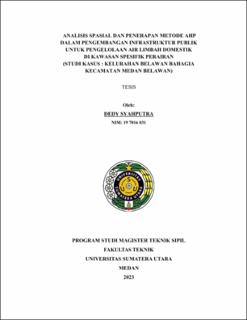Analisis Spasial dan Penerapan Metode AHP dalam Pengembangan Infrastruktur Publik untuk Pengelolaan Air Limbah Domestik di Kawasan Spesifik Perairan (Studi Kasus : Kelurahan Belawan Bahagia Kecamatan Medan Belawan)
Spatial Analysis And Application of the AHP Method in the Development of Public Infrastructure for Domestic Wastewater Management in Specific Water Area (Case Study: Belawan Bahagia Sub-District Medan Belawan District)

Date
2023Author
Syahputra, Dedy
Advisor(s)
Mulia, Ahmad Perwira
Khair, Hafizhul
Metadata
Show full item recordAbstract
Sanitation problems in specific water areas are an issue of current concern.
The provision of sanitation infrastructure, especially domestic wastewater, is one
of the basic needs of society and has a strategic role in improving the quality of
health and welfare of the community. Belawan Bahagia Sub-district is a water
residential area with the densest population density in Medan Belawan District,
namely 22,865 people per Km2. Belawan Bahagia Subdistrict, as a coastal
residential area, is also an area with a very high level of tidal flood vulnerability.
The intensity of tidal floods occurs twice every month. This research aims to
determine appropriate domestic wastewater management technology in Belawan
Bahagia Sub-district. Analysis was carried out based on technical, social,
environmental, institutional and financial aspects using the Analytical Hierarchy
Process (AHP) method. The results of the analysis are then integrated spatially
based on the level of tidal flood vulnerability in each environment in Belawan
Bahagia Sub-district. The research results show that floating pods technology and
a dry toilet system with separate containers are the most suitable technologies to
be implemented in Bahagia Sub-district with a score for floating pods of 0.845 and
dry toilets with separate containers of 0.661. The factors that form the basis for
selecting these two technologies are their ability to provide services and respond
to weather conditions, namely tidal floods. Efficiency of raw materials and a good
waste minimization concept are also considerations in selecting this technology.
Biofiltration and Tripikon-S technology can only be applied in areas with a
moderate level of vulnerability. Meanwhile, Septictank and Anaerobic Baffled
Reactor (ABR) technology are alternative technologies that can only be applied in
areas with a low level of vulnerability so they cannot be applied at all in Belawan
Bahagia Sub-district.
Collections
- Master Theses [278]
